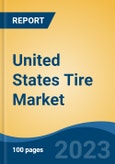Speak directly to the analyst to clarify any post sales queries you may have.
10% Free customizationThis report comes with 10% free customization, enabling you to add data that meets your specific business needs.
Key Market Drivers
Rising Vehicle Ownership and Fleet Expansion
The steady increase in vehicle ownership in the United States is a significant factor driving tire demand. With a growing number of registered vehicles across segments - including passenger cars, SUVs, and commercial trucks - there is a continuous need for original and replacement tires. Expanding commercial and ride-sharing fleets are further boosting this demand, as these vehicles typically experience higher usage and require more frequent tire replacements. Fleet operators, logistics companies, and delivery services represent a key segment fueling aftermarket growth. According to the U.S. Tire Manufacturers Association (USTMA), total tire shipments in the country are expected to reach 340.4 million units in 2025, up from 337.3 million units in 2024, surpassing pre-pandemic levels. This trend underscores the sustained momentum in tire consumption supported by increased vehicle use, replacement needs, and technological advancements.Key Market Challenges
Volatility in Raw Material Prices
Price fluctuations in raw materials pose a major challenge for tire manufacturers in the U.S. Tires are composed of multiple materials such as natural rubber, synthetic rubber, carbon black, and steel - all of which are vulnerable to global commodity price shifts. For instance, changes in crude oil prices directly impact the cost of synthetic rubber and other petroleum-based components.Similarly, natural rubber supply disruptions due to geopolitical instability, climatic conditions, or trade barriers in producing regions can lead to increased manufacturing costs. This volatility affects the entire supply chain and complicates pricing strategies for companies. For small and mid-sized manufacturers, maintaining profitability while staying price-competitive becomes especially difficult. These uncertainties also hinder long-term planning and investment in product innovation.
Key Market Trends
Advancements in Tire Technology and Innovation
Technological progress is playing a pivotal role in shaping the U.S. tire market. Manufacturers are heavily investing in R&D to develop tires with enhanced performance characteristics - such as improved traction, fuel efficiency, longer lifespan, and better safety features. Smart tires equipped with embedded sensors are transforming tire maintenance and monitoring by providing real-time data on air pressure, temperature, and tread wear. This is particularly beneficial for fleet operators aiming to minimize downtime and optimize vehicle performance. Additionally, innovations like run-flat tires, low rolling resistance designs, and self-sealing technologies are gaining popularity due to their convenience and enhanced safety. The use of advanced materials such as silica and aramid, along with precision tread engineering, is enabling tire manufacturers to meet diverse performance requirements for different vehicles and driving environments.Key Market Players
- Michelin North America Inc.
- The Goodyear Tire & Rubber Company
- Bridgestone Americas Inc.
- Cooper Tire & Rubber Company
- Continental Tire The Americas LLC
- Pirelli Tire North America LLC
- Kumho Tire United States Inc.
- Yokohama Tire Corporation
- Toyo Tire United States Corp.
- Hankook Tire America Corp.
Report Scope:
In this report, the United States Tire Market has been segmented into the following categories, in addition to the industry trends which have also been detailed below:United States Tire Market, By Vehicle Type:
- Passenger Car
- Light Commercial Vehicle
- Medium & Heavy Commercial Vehicle
- Two Wheelers
- Others
United States Tire Market, By Tire Type:
- Radial
- Bias
United States Tire Market, By Demand Category:
- OEM
- Aftermarket
United States Tire Market, By Region:
- South
- West
- Northeast
- Midwest
Competitive Landscape
Company Profiles: Detailed analysis of the major companies present in the United States Tire Market.Available Customizations:
With the given market data, the publisher offers customizations according to a company's specific needs. The following customization options are available for the report.Company Information
- Detailed analysis and profiling of additional market players (up to five).
This product will be delivered within 1-3 business days.
Table of Contents
Companies Mentioned
- Michelin North America Inc.
- The Goodyear Tire & Rubber Company
- Bridgestone Americas Inc.
- Cooper Tire & Rubber Company
- Continental Tire The Americas LLC
- Pirelli Tire North America LLC
- Kumho Tire United States Inc.
- Yokohama Tire Corporation
- Toyo Tire United States Corp.
- Hankook Tire America Corp.
Table Information
| Report Attribute | Details |
|---|---|
| No. of Pages | 81 |
| Published | July 2025 |
| Forecast Period | 2024 - 2030 |
| Estimated Market Value ( USD | $ 29.26 Billion |
| Forecasted Market Value ( USD | $ 40.21 Billion |
| Compound Annual Growth Rate | 5.4% |
| Regions Covered | United States |
| No. of Companies Mentioned | 10 |









